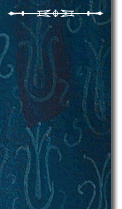


 |
 |
|
Feature :: Page 2 :: The Chimes They Are A-Changin'
Jump to Page 1 : >2< : 3 : 4 of The Chimes They Are A-Changin'
He graduated from Oberlin and cofounded his first major ensemble, the Blackearth Percussion Group. The musicians dug into a residency at Northern Illinois University, happy to make a living doing what they loved. Kvistad kept his hands busy, and in 1977 earned a master’s degree in music, fashioning an unusual course of study with classes in woodworking, metalworking, acoustics, music, and art. He met Diane Herrick, an artist and his future wife, who moved with him and Blackearth to the University of Cincinnati College Conservatory of Music. It was a step up for Kvistad—now an associate professor—who recorded and toured with the group throughout North America and Europe.
 Yet Kvistad was restless. Craving more improvisation and musical variety,
he yielded to an inner voice nagging him to leave teaching behind.
He and Diane
drove east during spring break one year, exploring the small towns and ultimately
falling in love with Woodstock. Nestled in New York’s Hudson Valley, the
legendary art colony was home to Karl Berger’s Creative Music Studio, considered
the premier center for the study of contemporary music. Kvistad landed
Yet Kvistad was restless. Craving more improvisation and musical variety,
he yielded to an inner voice nagging him to leave teaching behind.
He and Diane
drove east during spring break one year, exploring the small towns and ultimately
falling in love with Woodstock. Nestled in New York’s Hudson Valley, the
legendary art colony was home to Karl Berger’s Creative Music Studio, considered
the premier center for the study of contemporary music. Kvistad landed
a teaching position there and moved into a farmhouse nearby.
Friends said he was crazy. Relying on Diane’s artwork sales and his own meager income was a risky step for someone who could have settled into a cushy, secure life in academe. But the move, says Kvistad, was when he came into his own.
“It was one of those situations in which your parents think you’re crazy for quitting a university job and moving to the woods to make wind chimes,” he says. “But I was following my instincts.”
His instincts were born of bread and audiotape. As a youngster, Kvistad worked in his father’s plumbing components factory. Seeking ways to make more money, he took bread orders from the women workers and delivered them fresh from an Italian bakery the next morning, pocketing a nickel a loaf. In high school, he recorded student jazz concerts and earned money from dubs he made for friends.
In Woodstock, Kvistad found a place to test his latent entrepreneurial drive. He and Diane made chimes at the kitchen table, which they sold from booths at craft shows. In those days, the late 1970s, wind chimes were rare, the purview of artists who created them as visual art. Shoppers wanted to know what Kvistad’s homely chimes, made from discarded lawn chair tubing, were for. But once they heard the music, they were sold. The early chimes were carefully tuned to an ancient Greek pentatonic scale and had such an unusually beautiful sound that when Kvistad and his Chimes of Olympos were featured on National Public Radio in 1981, orders poured in from around the country.
![]()